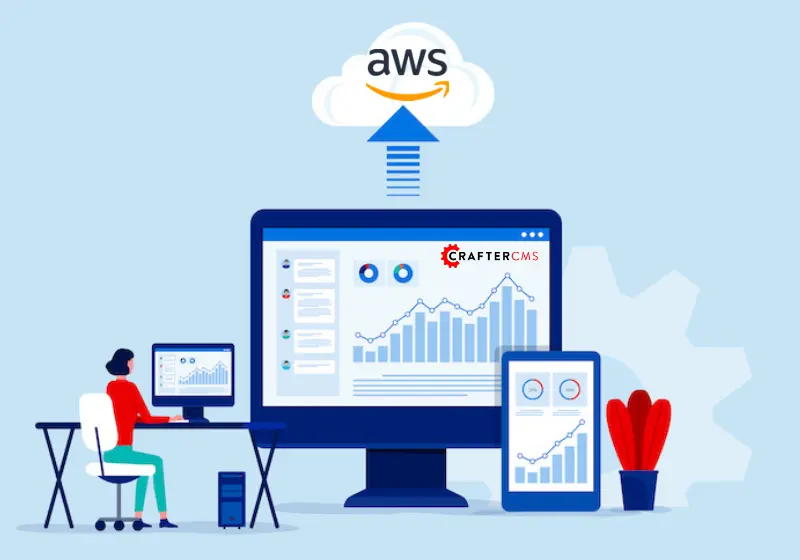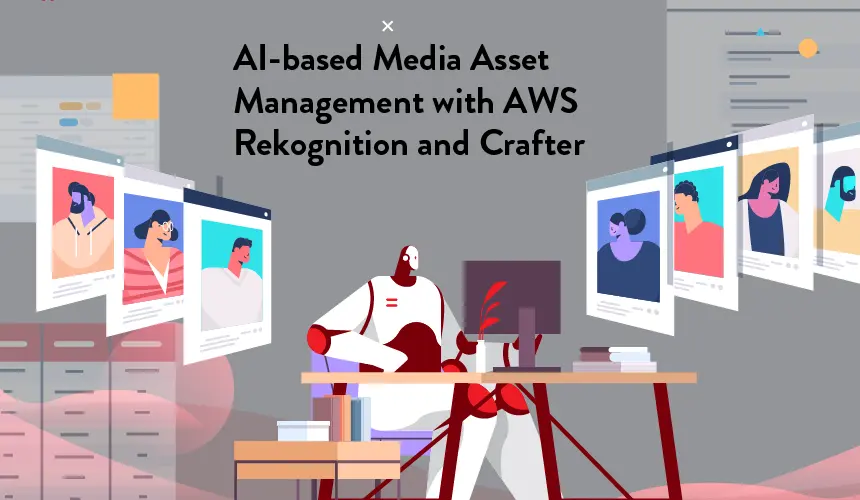What is an AWS CMS?

Sara Williams

Amazon Web Services (AWS) is the most widely used cloud platform globally, and AWS has the market share to prove it. By the end of Q1 2023, AWS held 32% of the cloud infrastructure market share.
The benefits of AWS go beyond cloud computing services, as organizations can leverage AWS to deploy content-rich web applications powered by CMS. In this article, we’ll dive into AWS, provide an overview of some of its key cloud services for content management, and explain how an AWS CMS works and its use cases.
What is AWS?
AWS provides a highly reliable and scalable platform for cloud computing that companies and individuals can use to power their infrastructure and software applications. With a global reach, AWS provides the agility and elasticity that enables brands to innovate and remain agile to adjust to meet growth and demand.
Access to on-demand delivery of various cloud services is available across several regions and availability zones connected through a low latency, high throughput network. This ensures that enterprises can benefit from the several services offered by AWS.
What is an AWS CMS?
An AWS CMS is a cloud-based content management system hosted on AWS. Like other cloud or SaaS CMS platforms, an AWS CMS provides users a flexible and scalable solution for creating and managing digital content experiences. As an AWS CMS is hosted on the Amazon Web Services cloud, this provides access to all of the tools and services that enable agile software application development, high availability, serverless content delivery, elastic scalability, cost effectiveness and other benefits.
What is an AWS Headless CMS?
An AWS headless CMS is a headless CMS that leverages AWS infrastructure to deliver content experiences to customers across multiple channels. With headless architecture and AWS, a headless AWS CMS enables businesses to create and manage personalized experiences for not only global enterprise websites, but also customer portals, employee intranets, consumer mobile apps, ecommerce websites, digital signage, OTT video apps, among many other digital experiences.
Why Choose an AWS Headless CMS Over Azure or GCP
Organizations considering a cloud-based solution for their headless CMS will need to choose between different cloud service providers for deployment. There are several benefits to choosing AWS over Azure, Google Cloud Platform, and others:
Market Leadership & Maturity
AWS is the leader in cloud computing and was the first cloud provider, launching around when the cloud first became a reality in 2006. AWS’ dominance has remained consistent over the years and can be seen in the vast customer base.
Wide Range of Cloud Services
AWS offers a range of cloud services across computing, storage, databases, artificial intelligence, machine learning, IoT, and more. These services can be used to power content experiences and support a robust CMS.
Global Reach
AWS offers a global infrastructure with data centers in more regions worldwide. This includes 102 Availability Zones within 32 geographic regions worldwide, and further expansion on the way. Such reach is crucial for global enterprises and businesses requiring low-latency access in various locations.
Specialized Vertical Solutions
AWS has developed industry-specific solutions for sectors like healthcare (AWS Healthcare) and financial services (AWS Financial Services). These services can be combined with AWS’ content management-focused services, allowing easy integration for a headless AWS CMS and smoother operations for the business.
Ecosystem Support
AWS has a large community and extensive documentation. This can make it easier to find resources, solutions, and expertise.
Key AWS Services For Content Management
AWS’s broad array of services enables the platform to provide several products and services. Some of the ones most relevant to content-rich web applications include:
Amazon EC2
Amazon Elastic Compute Cloud (EC2) provides resizable compute capacity in the cloud, enabling companies to increase or decrease their capacity and scale their services and applications as required.
Amazon S3
An object storage service used to store and protect data no matter the use case. With S3, enterprises can store data for a host of applications.
Amazon EKS
Amazon Elastic Kubernetes Service (EKS) provides the flexibility to start, maintain, and scale Kubernetes applications in the cloud. It provides highly available and secure clusters, which make it easier to run serverless applications on AWS.
Amazon AI/ML
AWS provides machine learning services that enable developers and data scientists to add artificial intelligence to applications, such as object recognition within images and videos, speech recognition, recommendations for personalized experiences, and more.
Amazon Opensearch
Amazon Opensearch (the open source fork of Elasticsearch) enables the deployment of an Opensearch cluster quickly and easily, which delivers high-powered search for both the content authoring experience (e.g., to find, modify, reuse and repurpose existing content) and content delivery (e.g., to enable faceted navigation, search and content targeting within your content applications).
Amazon Cognito
Amazon Cognito provides authentication and authorization services that allow you to add user sign-up / sign-in, control access to web applications, and personalized experiences.
AWS Elemental Media Services
Elemental Media Services is the sector of AWS that specializes in video workloads. AWS Media Services consists of services -- such as MedialLive, MediaPackage, and MediaConnect -- that provide the tools to deliver both live streaming and video-on-demand (VOD) experiences to your audience.
Amazon CloudFront
AWS’s content delivery network service delivers data, videos, applications, and APIs to customers worldwide. It provides fast content delivery and advanced security.
AWS Lambda
AWS Lambda allows you to run code without worrying about provisioning or managing servers. As a serverless computing platform, it enables code to run virtually for any type of application or backend service.
AWS Snowball Edge
AWS Snowball Edge accelerates the movement of offline data or remote storage to the cloud. You can migrate terabytes of data without storage capacity or compute limits. With AWS Snowball, it’s possible to achieve excellent application performance even in disconnected or limited environments with no connectivity.
Each of these services can benefit an AWS CMS, but to leverage these components effectively, there are a few specific requirements.
Requirements for an AWS CMS
Cloud-Native
For a CMS to work with AWS, it needs to be cloud-native; in other words, built from the ground up for cloud deployments. Cloud-native software relies on microservices architecture and supports containerization. This enables the CMS to meet the demands of the current modern environment. For content delivery, elastic scalability is crucial; to fully support this, an AWS-friendly CMS should be stateless.
Stateless & Serverless
A stateless architecture enables separate instances of applications to operate independently. This allows content services to be deployed without any need for complicated synchronization schemes or shared resources. Stateless and serverless architectures can be deployed and managed with minimal IT operational requirements, most if not all of which can be automated.
Read More: How Crafter Cloud Works With AWS For Serverless Content Delivery
Elastic Scalability
An AWS CMS needs to have an elastic architecture to maintain high performance on a global scale. CMS-powered applications that are elastic can dynamically utilize resources as needed based on traffic and other performance requirements.
Well-Integrated
An AWS CMS needs to have native integrations with AWS services, especially Amazon EC2, EKS, S3, Opensearch, CloudFront, Elemental Media Services, and other services, depending on the type of digital experience applications the CMS powers. Many CMSs can run on AWS, but the out-of-the-box integrations of an AWS CMS enable it to leverage these cloud services without additional development work and maintenance.
Read More: Crafter Cloud: A Fully Managed CMS On Amazon Elastic Kubernetes Services
AWS CMS Use Cases
When AWS is combined with a modern CMS built to maximize the cloud’s potential, many use cases can be achieved. An AWS CMS provides the technology infrastructure required to implement several digital innovations. Here are a few examples:
Personalized, Planet-Scale Enterprise Websites
Today’s modern enterprise websites feature minimalistic designs, but more importantly, they are created with the customer in mind. Personalized and responsive websites deliver better customer experiences.
Also, larger enterprises can cater to visitors from all over the world and provide them with the most appropriate content for their particular region. Fast websites with a global reach are possible due to a cloud-native CMS built for AWS.
Mobile Apps & Multichannel Experiences
Consumers today don’t merely rely on modern websites; if they do, they may choose to access them via their mobile devices. An AWS CMS will provide an API-first developer experience to support native mobile app development and content delivery across many channels and devices. This enables companies to create multichannel experiences and meet customers wherever they are.
Live Video Experiences
Video content continues to grow in popularity, and the scalability, storage capacity, and functionality available through AWS means that enterprises can create, store, process, and distribute video content as desired. Applications include OTT video experiences for Smart TVs and mobile devices, and enterprise video experiences delivered through web browsers, virtual conferences, virtual museums, to name just a few.
An AWS CMS allows you to fully leverage the capabilities of AWS Media Services, including live streaming and VOD experiences. Video content management on AWS is the future of next-gen video experiences.
And Several More Use Cases
Other use cases that are perfectly suited for a headless CMS on AWS include:
Really, any content-centric digital experience that needs to engage a large audience and that must be high performance, secure, scalable and cost effective is a candidate for implementing with a headless CMS on AWS.
CrafterCMS: Built to Leverage the Power of AWS
For the ideal CMS capable of leveraging the cloud and all that AWS has to offer, look no further than CrafterCMS. CrafterCMS has the user-friendly features you require to create and manage omnichannel experiences on a global scale and the DevOps capabilities for building and deploying modern content-enabled applications in the elastic cloud.
CrafterCMS is an AWS headless CMS that goes way beyond traditional legacy CMS platforms and the simple headless-only CMS platforms. CrafterCMS’s WYSIWYG editor and easy-to-use drag/drop interface provide everything content authors require in a CMS.
Meanwhile, developers can count on CrafterCMS’s API-first, Git-based distributed content repository to streamline development processes and leverage its out-of-the-box integrations with AWS. CrafterCMS offers a cloud-native, microservices architecture and serverless, stateless content delivery system that enables elastic scalability. CrafterCMS’s ability to leverage most of AWS’s features provides exactly what an enterprise-level CMS requires.
Plus, CrafterCMS’s unique support for DevContentOps processes combines content authoring operations with DevOps to enhance how content-rich digital experiences are built and optimized for today’s modern digital landscape.
Want to learn more about how CrafterCMS integrates with AWS? Read our White Paper on Choosing a CMS for Building Content-Driven Sites and Apps on AWS.
Related Posts

Websites Are Dead?

Mike Vertal

No-Code Experience Building for Marketers & Designers

Amanda Lee

Is Your CMS MACH-Ready? A Practical Guide for Enterprise Architects

Sara Williams

Composable DXP vs Traditional DXP: Why Enterprises Choose CrafterCMS

Amanda Jones
Related Resources
-

CrafterCMS at eBay: The Universal Content Platform for eBay.com
Webcast
-

Personalized Digital Experiences for a Cruise Liner
Webcast
-

Introducing CrafterCMS v4.0
Webcast
-

Modernizing Video Delivery and Content Management at CPAC, A Canadian Nationwide Broadcaster
Webcast
-

AI-based Media Asset Management with AWS Rekognition and CrafterCMS
Webcast





